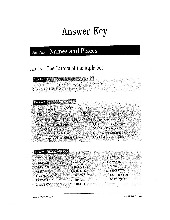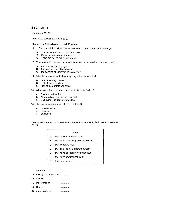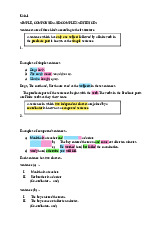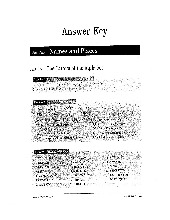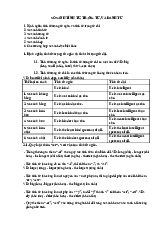




Preview text:
lOMoAR cPSD| 40342981
APTIS For Teens: Reading Practice Test #2
Part 1: Choose the word (A,B,C) that fits in the gap. The answer to question 0 is an example. Hey Ian,
I was just (0) _____ if you needed a ride to school tomorrow.
I saw you waiting for the (1.1) _____ at the stop.
Normally, I (1.2) _____ my bike, but now, it is winter.
Since the weather is getting (1.3) _____ , my dad drives me.
We pass by your house, so we can (1.4) _____ you up.
You are on the (1.5) ________ to school, so it’s no problem. Gillian 0. A. wondering B. thinking C. considering 1.1 A. bus B. car C. taxi 1.2 A. drive B. ride C. have 1.3 A. wetter B. colder C. warmer 1.4 A. get B. take C. pick 1.5 A. trip B. travel C. way
Part 2: The sentences below are from a teen’s journal. Order the sentences
(BF) to make a story. The first sentence (A) is an example. Bad Hair Day A
I’ve just had a terrible day at school B
Unfortunately, it was a windy day. C
As it was school photo day, I wanted to look my best. D
So, I spent one hour styling my hair before school. E
Furthermore, I couldn’t fix the mess because I forgot my brush. F
By the time I arrived at school, my hair had been ruined. 0. A. 2.1 ________ lOMoAR cPSD| 40342981 2.2 ________ 2.3 ________ 2.4 ________ 2.5 ________
The sentences below are from a school policy. Order the sentences (B-F) to
make a story. The first sentence (B) is an example.
Late Arrival Policy A
If you arrive at school late, you must follow these instructions. B
We have a very strict late arrival policy. C
However, before you receive this paper, you must be ready for class. D
There, you will get a signed and timed late slip from the secretary. E
That means you will have to hang up your coat and gather your belongings in your locker beforehand. F
Unless there is a mass weather-related delay, you are required to go to the office. 0. B. 3.1 ________ 3.2 ________ 3.3 _______ 3.4 ________ 3.5 ________
Part 3: Read the four opinions posted on a sports forum. Then, answer the questions.
Person A: I am really into sports, and am always up for trying new games. When I
travelled to Canada with my family, I tried curling. I have never played it before
because I live in a hot country. I thought it would be a piece of cake. How hard can a
sport that uses a broom be? Well, I was wrong. In fact, you actually need a lot of
upper body strength and balance to succeed. Needless to say, I’m writing this the
day after with bruises from falling over!
Person B: I had just moved to the United States and wanted to make friends at my
school, so I signed up for the football team. When I arrived at try-outs, we began with
some agility drills and the coach seemed pretty impressed with how fast I could sprint.
Then, we were asked to throw an oddly-shaped ball as far as we could, and I was lOMoAR cPSD| 40342981
confused. It was then I realized that the try-outs were for American football, not
European football, or soccer as it is called here. No wonder I was the smallest person there!
Person C: When I was younger, I never wanted to play team sports. My dad would
always encourage me to join a team, but I was not interested. It’s not that I don’t like
physical activity. I love individual activities like swimming and running. My sister, who
is the captain of her school’s volleyball team, teases me and says I can’t handle
competition. However, I think of myself as a very competitive person. I am always
trying to achieve new personal records and beat my last timing.
Person D: Growing up, my brothers used to watch professional basketball matches
on TV, but I never understood the appeal. Despite this, I fell in love with the energy in
the crowd of a live sports match. My school has a really great basketball team, and I
know a few people who are on it. I get really into the games and scream my loudest
to cheer on my friends. It makes me feel so proud. Playing it is a different story
though. You wouldn’t catch me on a basketball court even as a substitute! Which person …
4.1. prefers to be a spectator? ________
4.2 underestimated a sport? ________
4.3 received a compliment? ________
4.4 was misunderstood by family? ________ 4.5 set goals? ________
4.6 did not understand a task? ________
4.7 used a household object? ________
Part 4: Read the text. Match the headings (A-I) to the paragraphs. The answer
to question 0 is an example. There is one heading that you will not use. Fake News
(0) Novel computer virus can spread to humans! Missing Teen: Abducted by Aliens?
Climate change- not a big deal! Perhaps you have read shocking headlines similar to
these on magazines while waiting in line at the supermarket. Alternatively, you may
have seen them on a pop-up advertisement or on a link shared by a friend on a social
media account. It is normal that you are lured into picking up that magazine or clicking
on links to find out more. Not only are they meant to attract readers, but they are often misleading.
(5.1) How can we name this phenomenon? While the above headlines do not
inherently tell the whole story, they often correspond to an equally deceptive article.
Nowadays, the phrase ‘fake news’ is used frequently in media, but it often only refers
to texts that contain factually false information. However, in actual fact, a more
comprehensive definition goes beyond this. The umbrella term, ‘fake news’, also
includes satire, with the purpose of making readers laugh. It is also comprised of lOMoAR cPSD| 40342981
biased reports, particularly when they are used to support or disprove of an important figure or to make money.
(5.2) Spreading falsities in this manner is an age-old problem. In regards to satire,
parodies of true new stories were distributed on April Fools Day (April 1st) and often
taken back the next day. On a more political note, as early as in 17th century England,
fabricated reports of the king’s health or alleged crimes were circulated in an attempt
to overthrow a monarch. Furthermore, in an attempt to sell more newspapers,
journalists would exaggerate stories, such as those related to the notorious English
serial killer, Jack the Ripper.
(5.3) Despite not being as new as everyone thinks, fake news has been exacerbated
due to the Internet and social media. While it may have roughly the same purpose, it
is spread at a rate that was previously unimaginable. By sharing stories through a click
of a button, a large amount of people can read them before they are factchecked or
deemed to be untrue. Scarcely is it only the content being fictionalized. In today’s day
and age, it is often difficult to discern whether the source of the news is even credible.
(5.4) Let’s consider satire as an example. Though meant to be light-hearted and
humorous, news satire has become its own genre. It was believed to be started by a
reporter, Samuel Clemens, better known by his pen-name as the literary icon, Mark
Twain. Clemens would often write fictional yet realistic articles and pass them off as
real events in order to make people laugh. Today, popular sites such as The Onion
have made a name for themselves by doing so. This website offers funny spoof stories
that mimic real ones with the general understanding that they are not true.
(5.5) While identifying fake news isn’t always easy, there are some useful questions
that you can ask yourself as you are reading any text. Firstly, you should look at the
source. Is it credible? Why is the information being shared by this particular outlet?
Secondly, identify the opinion of the article. Is the author a journalist, a politician, a
story-teller? Does he/she have a message to promote? Finally, if you are still in doubt,
ask an expert on the topic. This could be your teacher or a fact-checking website.
(5.6) So how does this affect you? As students have to complete research projects
from time to time, using a non-reputable source can cause them to fail an assignment
or get in trouble with their teacher. With that in mind, teachers must guide their students
on how to identify fake news. It is more important than ever before for young people
to be able to think critically about what they read or hear. By learning these skills,
students can become independent learners and make informed decisions in the future.
In fact, many schools are incorporating media literacy into their curriculum.
(5.7) But what about in the real world? As fake news is shared so frequently, their
original source may get lost along the way and occasionally be broadcasted as true.
Are there any penalties for sources spreading misinformation? Well, in some countries,
there are. For instance, some countries in the European Union, like Germany, have
introduced large fines to social media sites that do not remove fake news. However,
others maintain that this goes against free speech and cannot impose any laws against
it. Regardless, it is a government’s responsibility to educate its citizens. A. Defining Terms lOMoAR cPSD| 40342981 B. A Problem Made Worse C. Helpful Tips D. Sensationalist Headlines E. Consequences Going Forward F. Historical Background G. How Schools Can Adapt H. Just for Laughs I. Doing Homework
